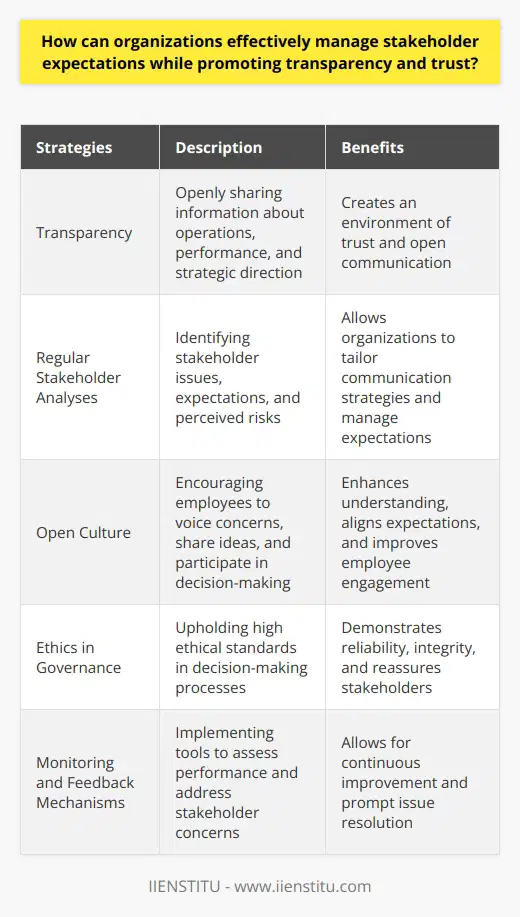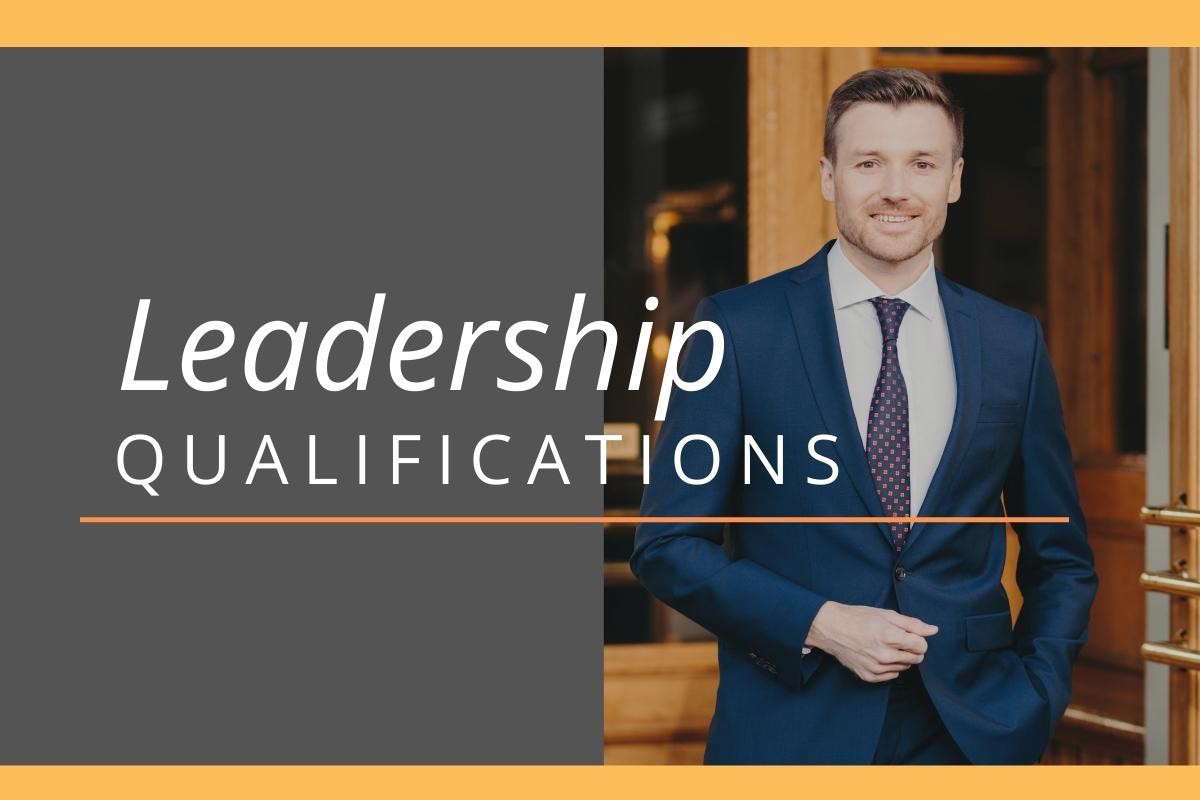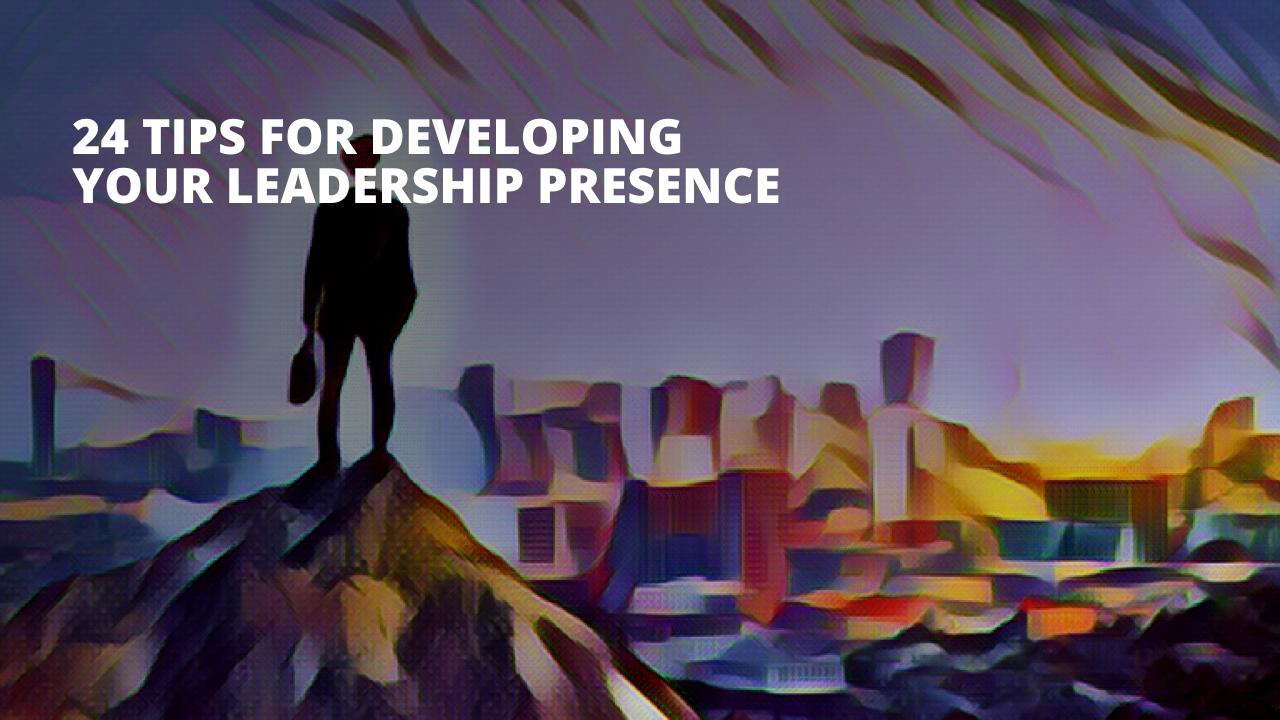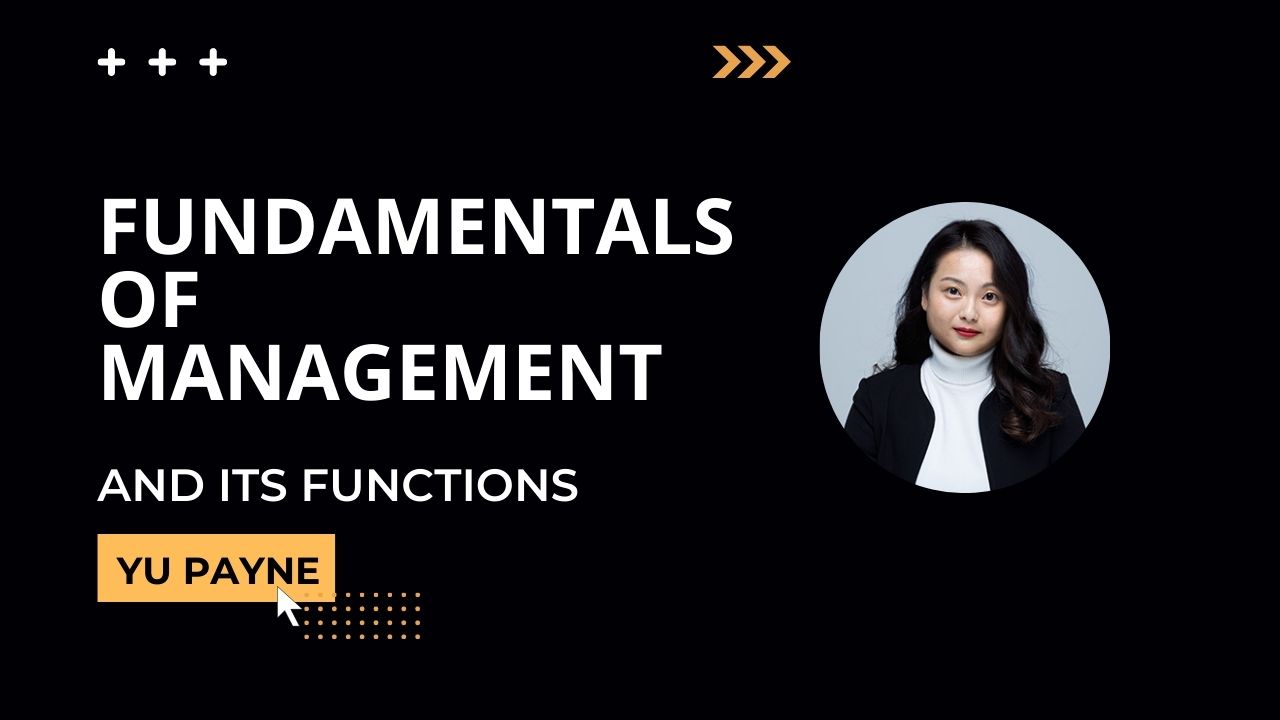
Defining an Impacted Stakeholder
Establishing a Two-Way Dialogue
Mutual Success Goal-Setting
Successful Engagement Strategies
Engaging impacted stakeholders—those affected by a project or organization—is critical for success. Because stakeholders represent varying viewpoints and interests, understanding and communicating with each other is necessary for mutual success. This blog will explore how establishing a two-way dialogue with stakeholders, goal-setting that strives for mutual success, and engagement strategies that are consistent and meaningful can elevate the success of any engagement process.
Defining an Impacted Stakeholder
Different terms have been used to refer to those an organization or project may impact, but the 'stakeholder' term has become the most commonly used. A stakeholder can influence or be affected by the outcome of a project or organization. For example, for a company introducing a new product, stakeholders may be internal staff, investors, suppliers, customers, target markets, etc. Each stakeholder must be identified to ensure they are included in the engagement process.
Establishing a Two-Way Dialogue
Engagement success is predicated on a two-way dialogue between stakeholders and the project or organization. Creating a communication platform where each stakeholder can hear and be heard is essential. Establishing an open and effective dialogue helps build understanding and trust between stakeholders. Listening to stakeholders' ideas and concerns can lead to beneficial outcomes and productive action. Avoiding rigid, top-down communication can improve engagement outcomes.
Mutual Success Goal-Setting
More than simply engaging the stakeholders in dialogue is required; steps should be taken to ensure mutual success. This means going beyond merely managing stakeholders' expectations and instead striving for mutually beneficial outcomes. Setting shared and understood objectives by all stakeholders is necessary for successful collaboration. When all stakeholders' interests are addressed, the likelihood of success increases significantly.
Successful Engagement Strategies
It's essential to manage the engagement process consistently so that stakeholders feel heard and accepted. An appropriate budget for engagement activities helps ensure stakeholders remain engaged over time. These activities should not be limited to meetings. Still, they may also include events, surveys, workshops, and other educational and public engagement efforts. Finally, it's critical to be responsive to both the outcomes of the engagement process and the stakeholders' feedback.
Conclusion: Engaging impacted stakeholders is a critical step for any successful project. Establishing a two-way dialogue, creating mutual success goals, and having effective engagement strategies are the foundations of successful stakeholder engagement. Tackling projects with this mindset will help ensure the success of any engagement efforts.
Success comes from engaging the stakeholders that are most impacted by the issue at hand.
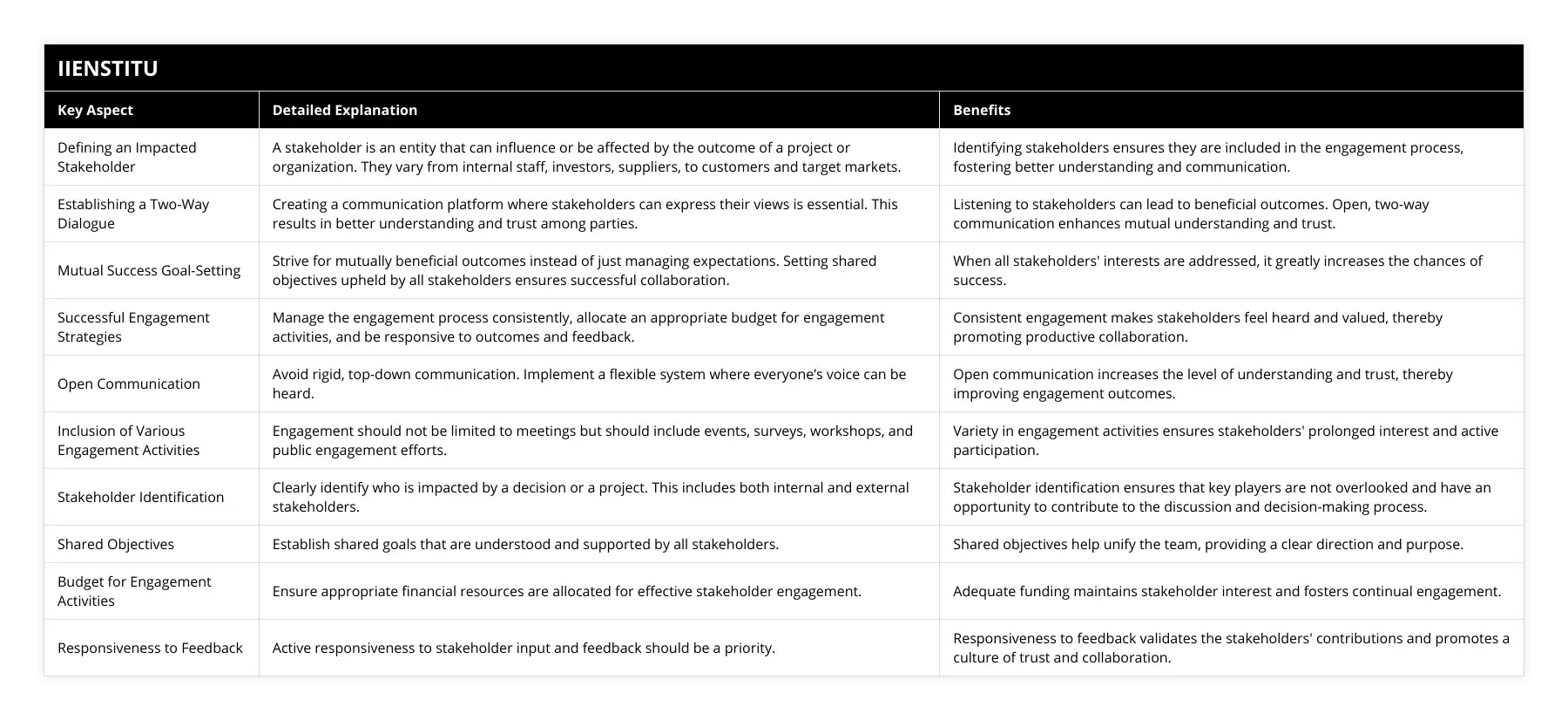
Frequently Asked Questions
What approaches can be used to effectively engage impacted stakeholders?
Engaging impacted stakeholders is an integral component of the success of any project. As such, it requires extra attention during the planning and execution of a said project. Using approaches tailored to the specific impacted stakeholders can vastly improve stakeholder engagement. In this article, I will discuss three approaches to effectively engaging affected stakeholders:
Emphasizing benefits
Utilizing stakeholder content
Cultivating an open, collaborative environment.
First, emphasizing the potential benefits to impacted stakeholders is an effective tactic for engaging stakeholders. This means clearly articulating to stakeholders the potential gains they can obtain by participating in the project. Whether it is a financial gain, an opportunity to learn something new, or simply the satisfaction of contributing to a worthwhile project, outlining the potential rewards of participation can be an enticing proposition. By focusing more on benefits that align with stakeholder goals, they will be incentivized to engage.
Second, utilizing stakeholder content can be a powerful tool for effectively engaging stakeholders. This means creating content like surveys, webinars, and informational videos tailored to stakeholders’ knowledge levels and interests. This can help garner stakeholders’ attention and allow them to provide feedback and input. Furthermore, this should be done in a collaborative setting whereby stakeholders can interact, learn from each other, and deepen their commitment to the project.
Finally, creating an open and collaborative environment is essential for effectively engaging impacted stakeholders. This means building a culture of trust, mutual respect, and collaboration from the beginning of the project. This can be achieved through frequent communication, using the stakeholder above content, and ensuring all stakeholders have an opportunity for active participation. Additionally, providing ways for stakeholders to address their grievances and validate their concerns can foster a positive relationship between stakeholders and the project.
All in all, effectively engaging impacted stakeholders is an essential component of the success of any project. This can be achieved through emphasizing benefits, utilizing stakeholder content, and cultivating an open, collaborative environment. Successful stakeholder engagement is within reach, with suitable approaches tailored to the unique needs of each project and its impacted stakeholders.
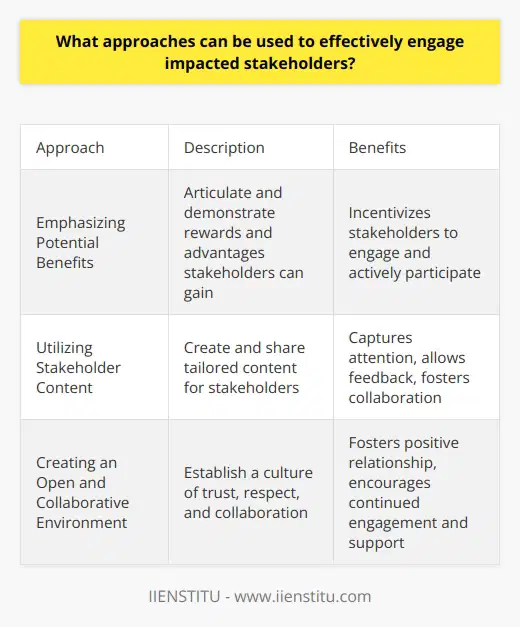
What are the major challenges and issues associated with engaging impacted stakeholders?
Stakeholder engagement is an essential process for any organization or project. Yet, engaging impacted stakeholders can present significant challenges and issues that should be adequately addressed. This paper will analyze some of the main challenges and issues organizations and projects must consider when engaging stakeholders.
The first significant challenge organizations and projects face when engaging impacted stakeholders is identifying who should be included in the process. Often, stakeholders fall into overlapping categories and could be placed in multiple ways. As a result, the identification process becomes complicated. In addition, it requires the stakeholders to be continuously reassessed and adequately informed of their engagement status.
The second challenge is ensuring open communication and stakeholder collaboration throughout the process. Provide stakeholders with direct and regular communication about the project’s purpose, goals, and expectations. This is especially relevant when working with engaged stakeholders because they may not be actively involved in the engagement process. Consequently, providing adequate resources and support is essential to promote an active and engaged engagement.
The third challenge associated with engaging impacted stakeholders is creating an inclusive environment that acknowledges the diversity of their perspectives and experiences. Organizations should strive to create an atmosphere of mutual respect that reflects the values and beliefs of all stakeholders. Furthermore, organizations should ensure that the project team has sufficient resources, knowledge, and expertise to address any issues arising during stakeholder engagement.
Finally, it is essential to measure the impact of the project on different groups of stakeholders. Organizations should demonstrate how stakeholder engagement has positively impacted their project or organization. This should be done through quantitative and qualitative indicators and reflect the approved objectives and goals of the engagement process.
In conclusion, stakeholder engagement is essential for any organization or project. Yet, engaging impacted stakeholders presents its own unique set of challenges and issues. These must be considered and addressed effectively and suitably to ensure a mutually beneficial outcome for all involved.

How can impactful and lasting relationships be established between the organization and impacted stakeholders?
Establishing meaningful and enduring relationships between organizations and impacted stakeholders is essential for enabling them to collaborate and effectively address challenges in any given context efficiently. The success of any such connection is predicated on mutual understanding, respect, trust, and open communication. Such relationships are best attained by implementing transparent practices that foster stakeholder engagement and collaboration.
To begin, organizations need to develop strong communication channels that facilitate stakeholder feedback and continuous dialogue. This can involve engaging stakeholders regularly in forums and events, creating shared spaces to discuss issues, or using social media platforms to keep them informed. In addition, for successful dialogue, organizations must ensure that the language used is accessible to those from different socio-economic backgrounds and cultures.
In addition, organizations should use a wide range of engagement techniques to ensure that all stakeholders have the opportunity to have their voices heard. This could range from providing an anonymous feedback platform to inviting stakeholders to on-site visits to‚ in more extreme cases‚ participation in decision-making processes. Such measures allow organizations to understand better stakeholders’ perspectives‚ which can be invaluable for producing successful outcomes.
Finally, organizations need to build relationships of trust and respect with impacted stakeholders by selecting appropriate partners with shared objectives. Involving knowledgeable and experienced stakeholders in designing collaborative approaches or projects is equally important. This is pivotal to the successful delivery of programs or services.
In conclusion, building impactful and long-lasting relationships between organizations and impacted stakeholders is a multi-faceted process that requires strategic thinking and open communication. Collaboration with stakeholders should be undertaken with sensitivity and an appreciation of the diversity of perspectives within the different stakeholder groups. Organizations can work more effectively and efficiently to produce positive outcomes when effective relationships are established.
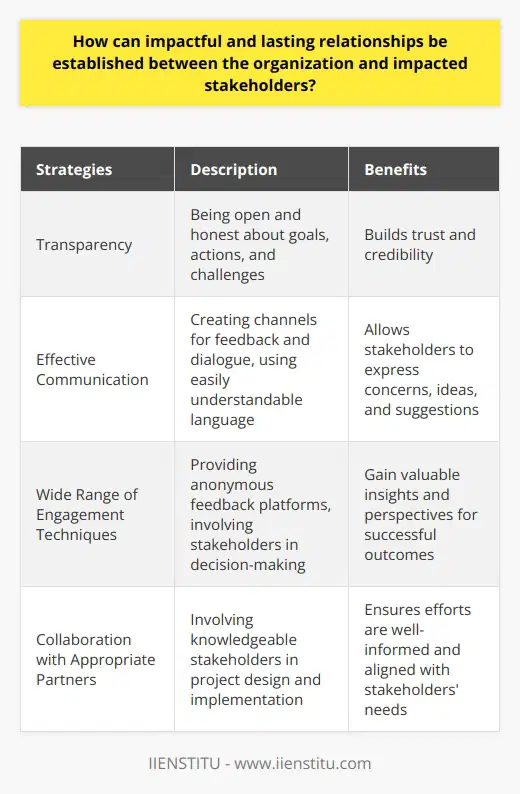
How do you build effective relationships with stakeholders?
Understanding Stakeholders' Needs
Building effective relationships with stakeholders begins with a thorough understanding of their needs, expectations, and concerns. Investing time in engaging with stakeholders, listening to their feedback, and incorporating their perspectives into decision-making processes helps establish trust and a sense of collaboration. Furthermore, this fosters an environment where stakeholders are more likely to champion and support organizational objectives, as they feel they have a stake in its success.
Transparent Communication
Maintaining clear and transparent communication with stakeholders is critical. They need to be well-informed about the organization's plans, progress, and any potential changes that may affect them. Sharing information through various channels, such as meetings, emails, and newsletters, ensures that stakeholders remain up-to-date and engaged. Communication should be a two-way process, where feedback from stakeholders is actively solicited and acknowledged. Transparency helps build credibility and foster trust, essential elements of strong stakeholder relationships.
Inclusive Decision-Making
Involve stakeholders in decision-making processes to ensure their concerns and insights are considered. Inclusion not only facilitates better decision-making by incorporating diverse perspectives but also improves stakeholder satisfaction and ownership of the outcomes. While it might not be feasible to involve all stakeholders in every decision, relevant parties should be consistently engaged based on the context and impact of the decision.
Establishing Shared Goals
A shared vision and common goals are key to fostering solid relationships with stakeholders. Collaboratively developing objectives that align with the interests of the organization and the stakeholders creates a platform for collective action, where all parties feel motivated to work together for mutual benefit. Negotiating and compromising on certain aspects might be necessary, but these discussions can lead to well-rounded solutions and stronger bonds between the organization and stakeholders.
Continual Improvement
Finally, one must continually evaluate and revise strategies for building and maintaining stakeholder relationships. Assessing performance metrics, reviewing feedback, and conducting stakeholder satisfaction surveys can provide valuable insights into what is working well and areas that require improvement. Emphasizing a commitment to learning and adapting demonstrates to stakeholders that their engagement is valued and that the organization is actively striving to achieve optimal results.
In conclusion, building effective stakeholder relationships requires understanding stakeholders' needs, transparent communication, inclusive decision-making, shared goals, and adaptability. By implementing these strategies, organizations are well-positioned to foster productive relationships that contribute to their success and the satisfaction of their stakeholders.
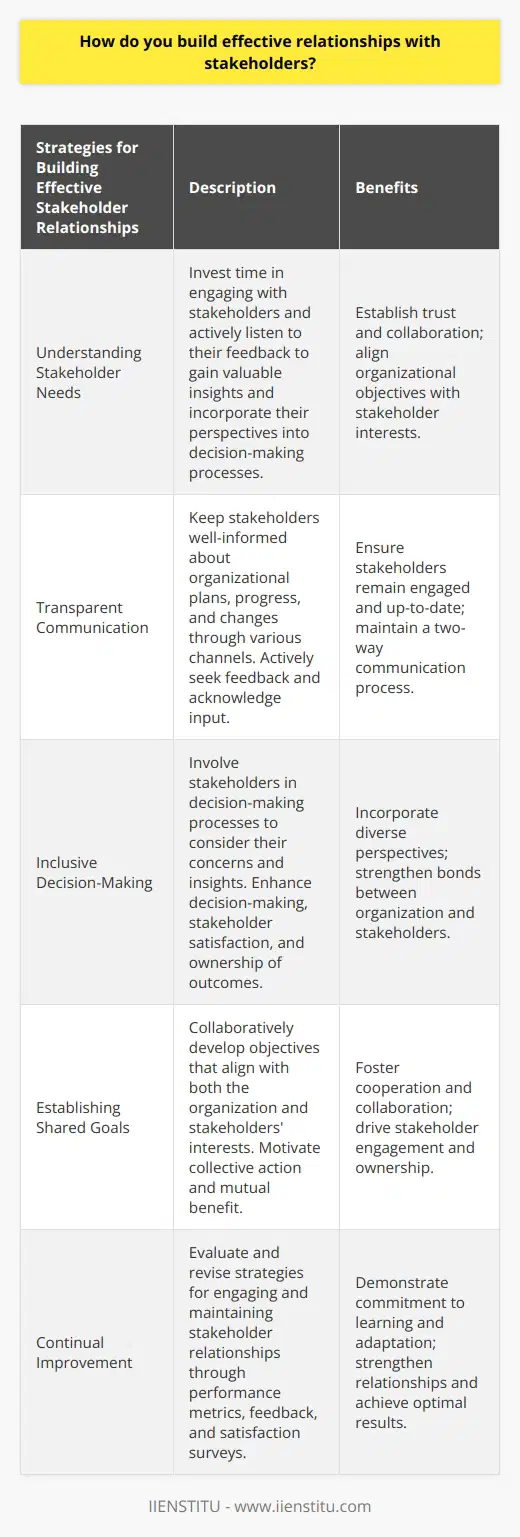
Why is it important to maintain good relationships with stakeholders?
Importance of Good Relationships with Stakeholders
Enhancing Trust and Loyalty
Maintaining strong relationships with stakeholders is crucial for several reasons. First, building trust and loyalty leads to a more supportive and collaborative working environment. When trust exists between the organization and its stakeholders, they are more likely to work effectively together towards common goals. A mutual understanding can lead to better decision-making and long-term success for both parties.
Avoiding Conflicts and Misunderstandings
Second, good relationships help prevent conflicts and misunderstandings. Clear communication is essential for managing expectations and addressing any concerns that may arise. Addressing stakeholders' needs and being receptive to their feedback promotes open dialogue, allowing potential issues to be addressed promptly. This proactive approach can prevent conflicts from escalating and damaging the organization's reputation.
Access to Resources and Opportunities
Third, strong relationships with stakeholders can provide organizations with access to valuable resources and opportunities. When stakeholders have a positive relationship with an organization, they are more likely to invest their time, energy, and capital into its initiatives. This support can be invaluable for achieving goals and securing competitive advantages in the marketplace.
Improved Decision-Making
Another benefit of good relationships with stakeholders is that they contribute to better decision-making. By engaging with stakeholders and seeking their input, organizations can gain diverse and valuable perspectives that inform their strategic direction. This collaboration can lead to more informed decision-making, ensuring that the best interests of all stakeholders are considered in the decision-making process.
Enhanced Reputation and Credibility
Finally, maintaining good relationships with stakeholders contributes to an enhanced reputation and credibility for the organization. When an organization demonstrates that it values its stakeholders and prioritizes their needs, it is more likely to be perceived as a responsible and ethical entity. This reputation can result in increased support, better opportunities, and stronger connections with other organizations and partners.
In conclusion, cultivating strong relationships with stakeholders is essential for organizations looking to achieve their strategic goals and ensure their long-term success. Not only do good relationships lead to improved communication and trust, but they also facilitate better decision-making, access to resources, and enhanced reputation. It is in the best interests of organizations to prioritize positive and collaborative relationships with their stakeholders.
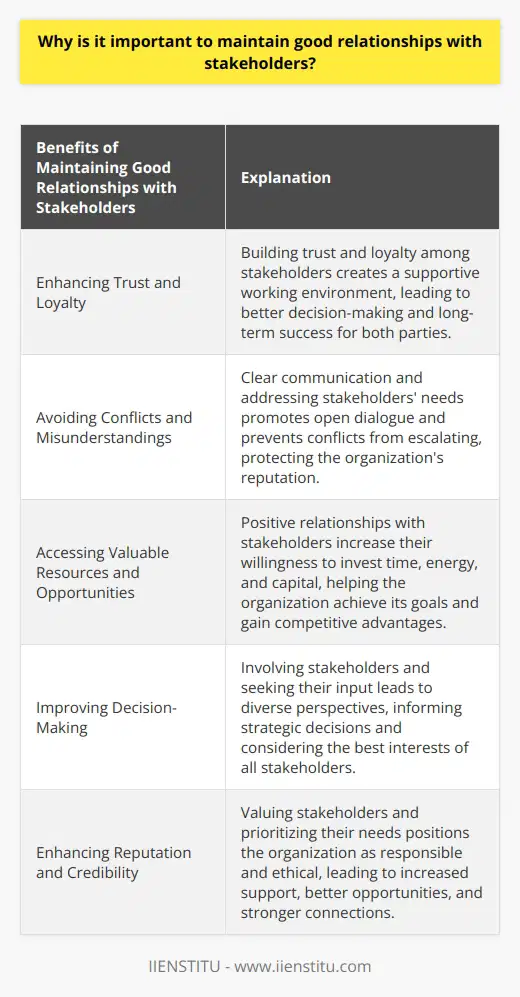
What are five examples of stakeholder engagement strategies methods?
Stakeholder Identification and Prioritization
Firstly, identifying and prioritizing stakeholders allows organizations to focus their engagement efforts on the most relevant parties. By conducting stakeholder mapping, organizations can categorize potential stakeholders based on their level of influence and interest in the project, leading to more effective and efficient engagement strategies.
Open Communication and Information Sharing
Secondly, open communication and information sharing with stakeholders are vital to ensure transparency and build trust. Regular updates through various channels, such as newsletters, emails, and meetings, help keep stakeholders informed of project progress and any changes that may impact their interests. This ongoing dialogue enables stakeholders to share their opinions, concerns, and ideas, leading to improved decision-making and collaboration.
Consultations and Feedback
Thirdly, consultations and feedback initiatives provide opportunities for stakeholders to contribute their expertise and perspectives to project development. These may include workshops, focus groups, surveys, or one-on-one interviews, depending on the desired level of engagement and the specific information sought. Such methods empower stakeholders to express their views and expectations, and provide organizations with valuable insights to inform their decision-making processes.
Collaborative Decision-Making
Fourthly, involving stakeholders in the decision-making process enables them to be better integrated into project development. By creating opportunities for stakeholders to participate in critical choices, organizations can incorporate diverse perspectives, fostering a more comprehensive decision-making process. This collaborative approach helps to address potential challenges and ensures that all stakeholder interests are represented in project outcomes.
Capacity Building and Education
Lastly, capacity building and education initiatives help to equip stakeholders with the necessary knowledge and skills to engage effectively in project development. By providing training, resources, and support, organizations can ensure that stakeholders are adequately prepared to participate in engagement initiatives, creating more meaningful interactions and contributions. This not only enhances stakeholder engagement but also fosters a sense of ownership and commitment to project success.
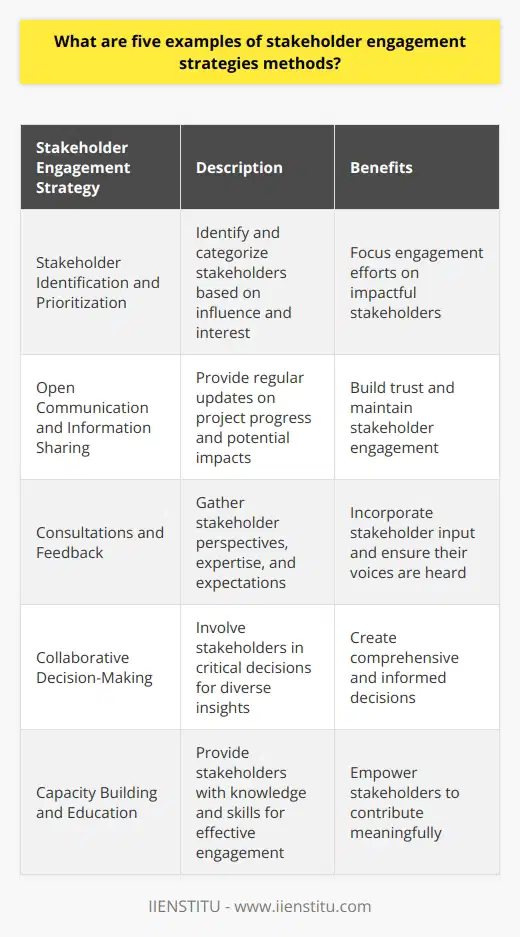
How does stakeholder engagement impact project success?
The Importance of Stakeholder Engagement
Stakeholder engagement is a crucial aspect in determining project success. By actively involving individuals or groups who have a vested interest in the project, it becomes feasible to identify and address potential issues and obstacles, thus improving project outcomes. In this regard, stakeholder engagement impacts project success through several dimensions: communication and transparency, resource allocation, and collaborative decision-making.
Enhanced Communication and Transparency
Effective communication is vital for managing project risks and resolving disputes. Through consistent and transparent engagement with stakeholders, project managers can gather valuable inputs to drive decisions and devise informed strategies. By addressing stakeholder concerns early in the process, project teams can create an atmosphere of trust and mutual understanding, fostering a positive working environment that accelerates project completion and improves overall results.
Optimized Resource Allocation
Additionally, stakeholder engagement aids in the optimal allocation of resources, which is critical for the project's financial and operational performance. Engaging stakeholders allows project managers to harness critical insights and expertise, leading to better-informed decisions about resource deployment. Adequate resource management lowers costs, reduces waste, and maximizes efficiency—ultimately driving project success.
Collaborative Decision-making
By facilitating collaborative decision-making, stakeholder engagement encourages more innovative and effective solutions. When stakeholders work cohesively, they tend to develop a sense of ownership over the project, translating into a greater commitment to its success. Collaborative decision-making can result in higher quality outcomes, as stakeholders align their efforts towards a shared objective and hold one another accountable.
In conclusion, stakeholder engagement plays a pivotal role in project success by improving communication and transparency, optimizing resource allocation, and fostering collaborative decision-making. These elements synergistically contribute to a project's ability to achieve its goals, ultimately leading to better overall outcomes. By understanding and leveraging the benefits of stakeholder engagement, project managers can enhance their project's prospects for success.

What is the impact of engaging stakeholders on decision-making processes and project outcomes?
Impact of Stakeholder Engagement
Active engagement of stakeholders in decision-making processes and project outcomes is crucial for the overall success of any project. Stakeholders can play an influential role in shaping decisions and outcomes through their direct and indirect input. Their involvement helps create a robust framework, resulting in better decision-making and project success.
Enhanced Decision-Making
Engaging stakeholders in the decision-making process fosters innovation and improved problem-solving capabilities. It brings diverse ideas and perspectives to the table, ensuring comprehensive consideration of various aspects of the project. Furthermore, involving stakeholders helps identify and address potential concerns, reducing the likelihood of disputes and ensuring project direction aligns with stakeholder expectations.
Increased Ownership and Accountability
Involving stakeholders in decision-making processes enhances their sense of ownership and accountability for the project’s outcome. By actively participating in the process, stakeholders become more vested in the project and its success, leading to higher levels of commitment and responsibility. This ownership is vital in achieving long-term project objectives and maintaining stakeholder support.
Improved Communication and Transparency
Engaging stakeholders in projects fosters open communication, increasing transparency and building trust. Transparent communication is crucial in ensuring stakeholder support and alignment, as it helps to manage expectations effectively. By involving stakeholders, potential misunderstandings and conflicts can be mitigated, paving the way for smooth project progress.
Adaptive Project Management
Lastly, actively engaging stakeholders enables a more adaptive approach to project management. By involving stakeholders in decision-making processes and project outcome assessments, organizations can detect any necessary changes and adapt accordingly. This adaptability enhances the project’s resilience, ensuring its success in a constantly changing environment.
In conclusion, the impact of engaging stakeholders in decision-making processes and project outcomes is substantial. It leads to enhanced decision-making, increased ownership and accountability, improved communication and transparency, and more adaptive project management. By actively involving stakeholders, organizations can improve the likelihood of a successful project and maintain long-term support from invested parties.
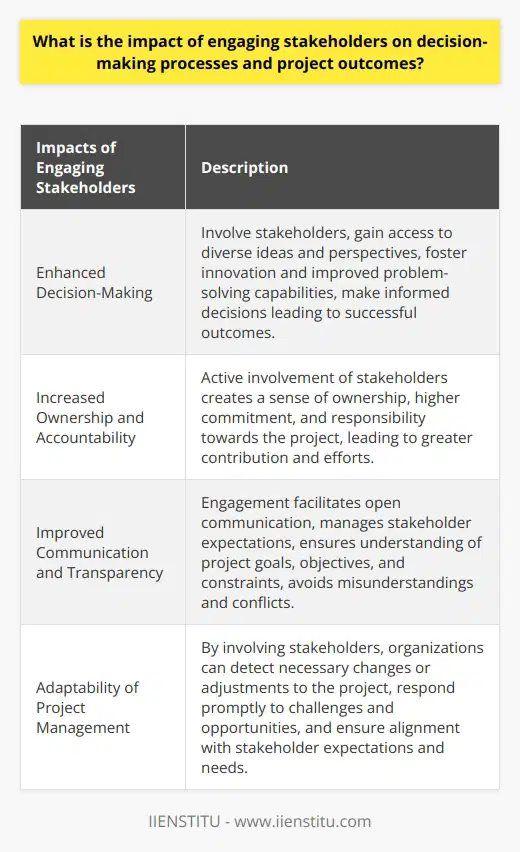
What are the 3 approaches to effectively influence and engage stakeholders during project development and implementation?
Three Approaches for Stakeholder Engagement
Identify and Prioritize Stakeholders
The first approach to effectively influence and engage stakeholders during project development and implementation is by identifying and prioritizing the stakeholders themselves. This can be achieved by performing a stakeholder analysis, which involves mapping out all potential stakeholders and determining their relevance, influence, and interest in the project. The stakeholders can then be classified into high, medium, and low priority groups to help the project managers allocate appropriate time and resources to engage with them effectively.
Develop and Implement Communication Strategies
The second approach involves the development and implementation of tailored communication strategies for each identified stakeholder group. This includes carefully crafting messages that address their specific needs, concerns, and priorities, as well as selecting appropriate communication channels and frequency. By communicating proactively and transparently, project managers can establish trust and rapport with stakeholders, promote a shared understanding of the project objectives, and facilitate collaboration and feedback throughout the project lifecycle.
Monitor and Evaluate Stakeholder Engagement
The third approach consists of monitoring and evaluating the effectiveness of stakeholder engagement activities during the project development and implementation phases. This requires project managers to establish clear goals, indicators, and metrics for engagement and to regularly assess the progress and outcomes of their efforts to adjust the engagement strategy as needed. By continuously evaluating and refining their engagement approach, project managers can foster long-term relationships with stakeholders, anticipate and address potential challenges and risks, and optimize overall project performance and outcomes.
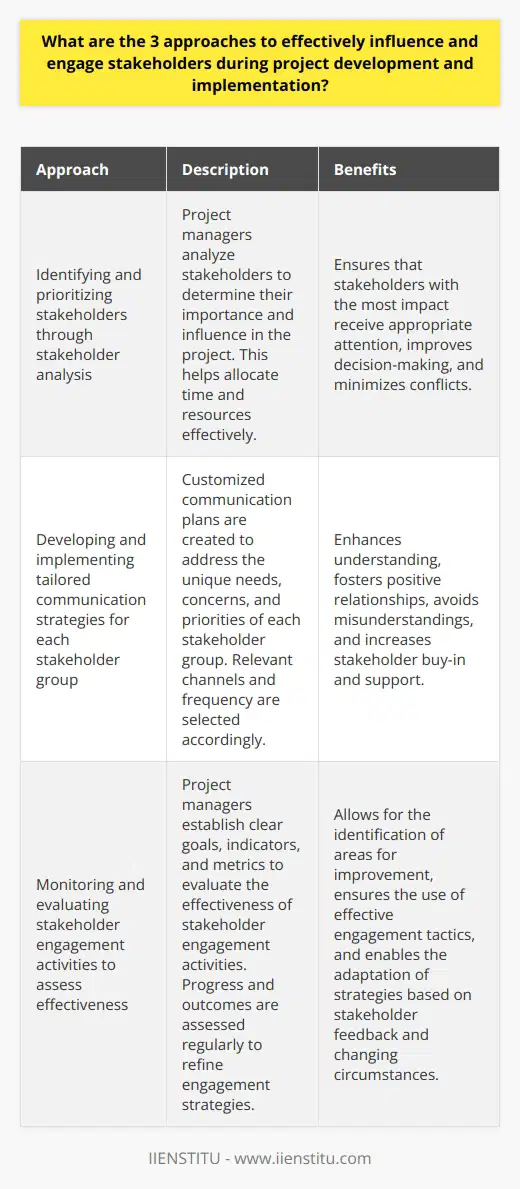
How do you successfully engage stakeholders in the decision-making process while managing potential conflicts and prioritizing their concerns?
**Stakeholder Engagement in Decision-Making**
Effectively engaging stakeholders in the decision-making process necessitates a proactive approach that emphasizes trust, communication, and collaboration. Strategies for fostering these qualities include identifying key stakeholders, actively seeking their input, and remaining objective and transparent in the decision-making process.
**Identifying Key Stakeholders**
To successfully engage stakeholders, it is critical to first determine who the main actors are and their relevance to the decision being made. Criteria for assessing importance may include each stakeholder's influence, level of expertise, or vested interest in the decision.
**Active Solicitation of Input**
Once key stakeholders are identified, it is crucial to solicit their input on the matter at hand. This can be achieved through interviews, surveys, or focus group discussions. Actively seeking their opinions and concerns demonstrates respect and acknowledges the value of their perspectives in the decision-making process.
**Objective and Transparent Decision-Making**
Maintaining objectivity and transparency throughout the decision-making process can help mitigate potential conflicts that may arise. By providing clear criteria and consistently adhering to them, stakeholders can understand the rationale behind each decision. Additionally, communicating openly about the process and the reasoning behind specific choices fosters an environment of trust and encourages stakeholders to express their concerns freely.
**Addressing Stakeholders' Concerns**
To balance competing interests and prioritize stakeholders' concerns, it is necessary to systematically evaluate each issue's relevance and priority. Employing techniques such as the Delphi method or multi-criteria analysis can be instrumental in generating a neutral, quantifiable assessment of each concern's importance.
**Adaptive Approach to Stakeholder Engagement**
As the decision-making process progresses, it is essential to continually reassess and adapt stakeholder engagement strategies. This may entail revisiting stakeholder identification, staying attuned to shifting priorities, or modifying communication channels to ensure optimal responsiveness.
In conclusion, successfully engaging stakeholders in the decision-making process requires an adaptive, proactive approach grounded in trust, communication, and collaboration. By identifying key stakeholders, soliciting input, and fostering a transparent and objective decision-making environment, potential conflicts can be managed and stakeholders' concerns appropriately prioritized.
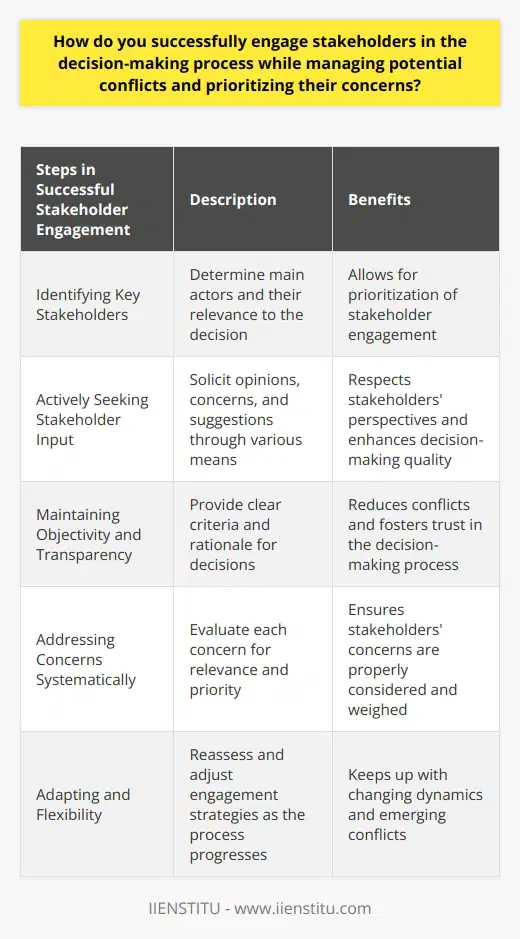
What are the critical factors that determine the effectiveness of stakeholder engagement strategies, and how can they be adapted to the specific context of a project?
Significance of Contextual Factors
Understanding the critical factors that influence the effectiveness of stakeholder engagement strategies is essential for successful project implementation. First, the specific context of a project plays a crucial role in shaping the approach to stakeholder engagement. Contextual factors such as cultural, political, and economic conditions need to be taken into account to ensure the engagement process aligns with the realities on the ground and respects local norms and values.
Stakeholder Identification and Prioritization
A second critical factor is the identification and prioritization of stakeholders. A thorough mapping exercise can help identify the relevant stakeholders to engage with, ensuring that their needs and interests are taken into consideration. Additionally, prioritizing stakeholders based on their influence, interest, and potential impact on the project aids in creating a focused and targeted engagement strategy.
Meaningful and Two-way Communication
Another important aspect is the promotion of meaningful and two-way communication. Effective stakeholder engagement hinges on the establishment of open channels that allow stakeholders to provide input, express concerns, and stay informed about project progress. This can be facilitated through forums, meetings, workshops, and digital platforms that ensure stakeholders feel heard and included in the decision-making process.
Alignment with Project Goals
Ensuring alignment between stakeholder engagement strategies and overall project goals is crucial for effectiveness. The engagement process should enable stakeholders to understand their role in the project and how their interests align with the overarching goals. This alignment aids in motivating and mobilizing stakeholders to work towards achieving these shared objectives.
Continuous Monitoring and Evaluation
Lastly, ongoing monitoring and evaluation of stakeholder engagement activities play a vital role in maintaining their effectiveness. Regular assessments enable feedback incorporation, which in turn contributes to the continuous improvement of the engagement process. By adapting the stakeholder engagement strategy in response to changing dynamics and stakeholder feedback, a project can ensure that the engagement remains effective throughout its lifecycle.
In conclusion, paying attention to contextual factors, identifying and prioritizing stakeholders, promoting meaningful communication, aligning engagement with project goals, and continuously monitoring and evaluating the engagement process are critical factors that determine the effectiveness of stakeholder engagement strategies. Adapting these strategies to the specific context of a project enhances their relevance and impact, ultimately contributing to a project's success.

In what ways can organizations measure the impact of stakeholder engagement on project outcomes and overall performance?
Methods of Evaluation
To assess the influence of stakeholder engagement on project outcomes and overall performance, organizations can adopt various evaluation methods. A comprehensive approach may involve examining both quantitative and qualitative indicators.
Quantitative Indicators
Return on Investment (ROI): A commonly used financial indicator, ROI can reveal the profitability of a project, thus showing the effectiveness of stakeholder engagement. By comparing ROI before and after implementing stakeholder engagement strategies, organizations can gauge the corresponding impact.
Key Performance Indicators (KPIs): Establishing KPIs for stakeholder engagement helps measure tangible outcomes. Examples of such KPIs include the number of meetings with stakeholders, levels of stakeholder satisfaction, and documented stakeholder feedback.
Project milestone completion: Analyzing progress in achieving project milestones can reveal the effectiveness of stakeholder engagement. Successful stakeholder engagement should lead to smoother project execution and timely completion.
Qualitative Indicators
Stakeholder Satisfaction: Feedback obtained from stakeholders helps determine their level of satisfaction with the organization's engagement efforts. A high level of satisfaction generally implies successful engagement and positive project outcomes.
Internal Stakeholder Perceptions: Gathering insights from internal team members can provide valuable information on stakeholder engagement efforts. Employees may be asked to evaluate the effectiveness of communication and collaboration between stakeholders and the project team.
Organizational learning: Assessing the lessons learned during stakeholder engagement processes can help an organization identify areas of improvement. A continuous learning process can enhance future engagements and lead to better project results.
In conclusion, organizations can employ a mixture of quantitative and qualitative indicators to measure the impact of stakeholder engagement on project outcomes and overall performance. Continuous evaluation of these indicators allows organizations to refine their stakeholder engagement strategies, thereby potentially improving project success rates and fostering long-term stakeholder relationships.
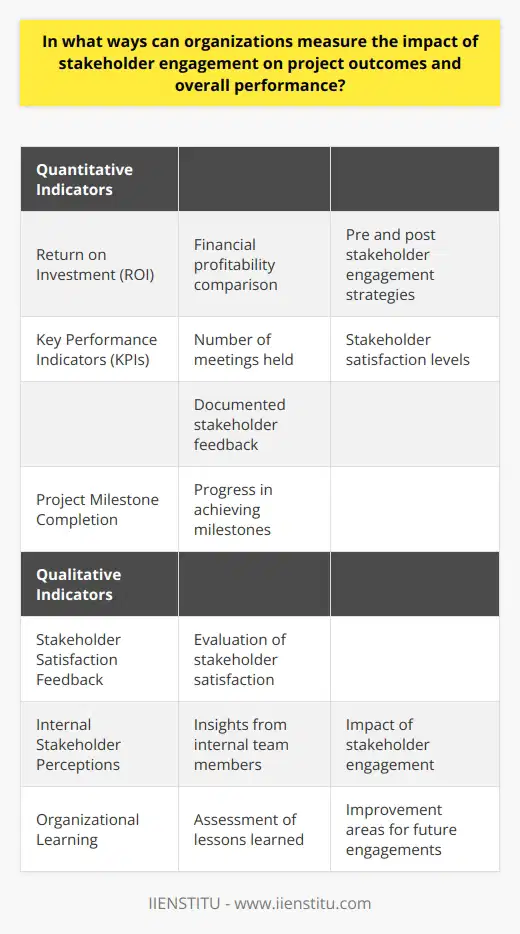
How does stakeholder engagement influence the decision-making process and contribute to project adaptability?
Stakeholder Engagement Impact on Decision-Making Process
Stakeholder engagement plays a crucial role in the decision-making process. It helps capture diverse perspectives and unique insights. Stakeholders can offer fresh ideas which enhance decision-making. Their level of involvement can lead to robust and well-rounded decisions.
Stakeholders Influence on Project Adaptability
Engagement with stakeholders also fosters project adaptability. Their feedback helps identify potential issues and risks early. By incorporating stakeholders’ input, project plans become more flexible. This flexibility influences the ability to adapt and adjust strategy accordingly.
Active Stakeholder Participation and Project Success
Active participation of stakeholders creates ownership feeling. Ownership leads to more commitment towards the project. A committed stakeholder will work diligently, contributing to project success. Moreover, their support can enhance the momentum of task completion, resulting in quick and efficient results.
Stakeholder Engagement and Resource Efficiency
Stakeholder engagement also ensures resource efficiency. It helps prioritize tasks based on stakeholder's input. Prioritization can lead to potent resource allocation, minimizing waste and maximizing output. In turn, this can improve overall project performance and deliver better outcomes.
Conclusively, stakeholder engagement holds significant influence over the decision-making process and project adaptability. Their active participation improves the quality of decision-making. Their insights enhance project flexibility, resource efficiency, and ultimately, the success of a project. It's imperative for organizations to foster a culture that values stakeholder engagement.

What is the role of communication and collaboration in ensuring successful stakeholder engagement?
Role of Communication
The act of conveying information plays a critical role in stakeholder engagement. Effective communication strategies foster a two-way process, through which the stakeholders get a holistic understanding of the mission, goals, and the progress of the organization. This exchange of information helps to build trust, secure buy-in, and promote participation among stakeholders. At the same time, stakeholders' feedback guides the organization, allowing it to align its performances to stakeholder expectations. Regular, clear, and concise communication ensures that stakeholders stay informed and involved in the project or organization.
Role of Collaboration
Collaboration complements communication in stakeholder engagement. It involves working together with stakeholders to achieve common goals. Through collaboration, stakeholders actively participate in decision-making processes, contributing their expertise and perspectives. This shared decision-making leads to better solutions, enhanced commitment, and increased satisfaction among stakeholders. Moreover, collaboration allows for the mitigation of conflicts and fosters a shared sense of ownership and responsibility amongst stakeholders.
Synergistic Role of Communication and Collaboration
To achieve successful stakeholder engagement, communication and collaboration must work in synergy. Communication facilitates the sharing of information, ideas, and feedback, while collaboration encourages active participation and contribution from stakeholders. This combination nurtures a constructive and interactive relationship between the organization and its stakeholders. It provides a platform that combines the strengths and resources of all participants, ultimately ensuring successful stakeholder engagement.
In conclusion, effective stakeholder engagement hinges on robust communication and collaboration strategies. These two factors act as the facilitators of understanding, trust, participation, and mutual growth between an organization and its stakeholders, and are thus vital to the success of any project or organization.
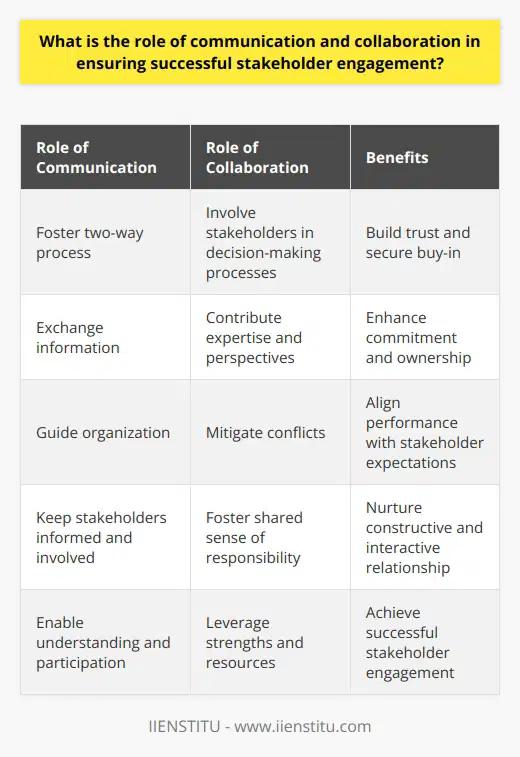
How can organizations effectively manage stakeholder expectations while promoting transparency and trust?
Promoting Trust and Transparency
Organizations can manage stakeholder expectations effectively by embracing transparency, a key aspect in building trust. Transparency involves open communication, which provides stakeholders with the necessary information about the company's operations, performance, and strategic direction.
Strategic Communication Practices
Engaging in regular, honest, and clear communication aids in managing expectations. This communication should detail the company's goals, plans, and potential challenges. It may include financial reports, official announcements, or regular briefings. It also helps counter misinformation.
Adapting to Stakeholders’ Needs
Understanding and addressing stakeholders' needs and concerns also play a crucial role. Conducting regular stakeholder analyses can provide valuable insights into their issues, expectations, and perceived risks. Using these insights, organizations can then tailor their communication strategy, making it more relevant and effective.
Creating an Open Culture
An open culture within the organization also promotes transparency. It encourages employees to voice concerns, share ideas, and be more involved. Participation enhances their understanding of the business, helping to align their expectations with the organization's objectives.
Implementing Ethical Governance
Ethics in governance is instrumental in fostering trust. By upholding high ethical standards in decision-making processes, organizations demonstrate their reliability and integrity. A firm commitment to ethical practices reassures stakeholders, implying that the organization takes their interests to heart.
Monitoring and Feedback Mechanisms
Organizations should establish monitoring and feedback mechanisms. These systems allow them to assess their performance and make necessary adjustments. They also provide a platform for stakeholders to voice their concerns and feedback.
In conclusion, effective management of stakeholder expectations requires an interplay of transparency, clear communication, openness, ethical governance, and adaptability to stakeholder needs. Organizations that embrace these practices will likely enjoy greater trust from their stakeholders and consequently, a wider margin for success in their operations.
